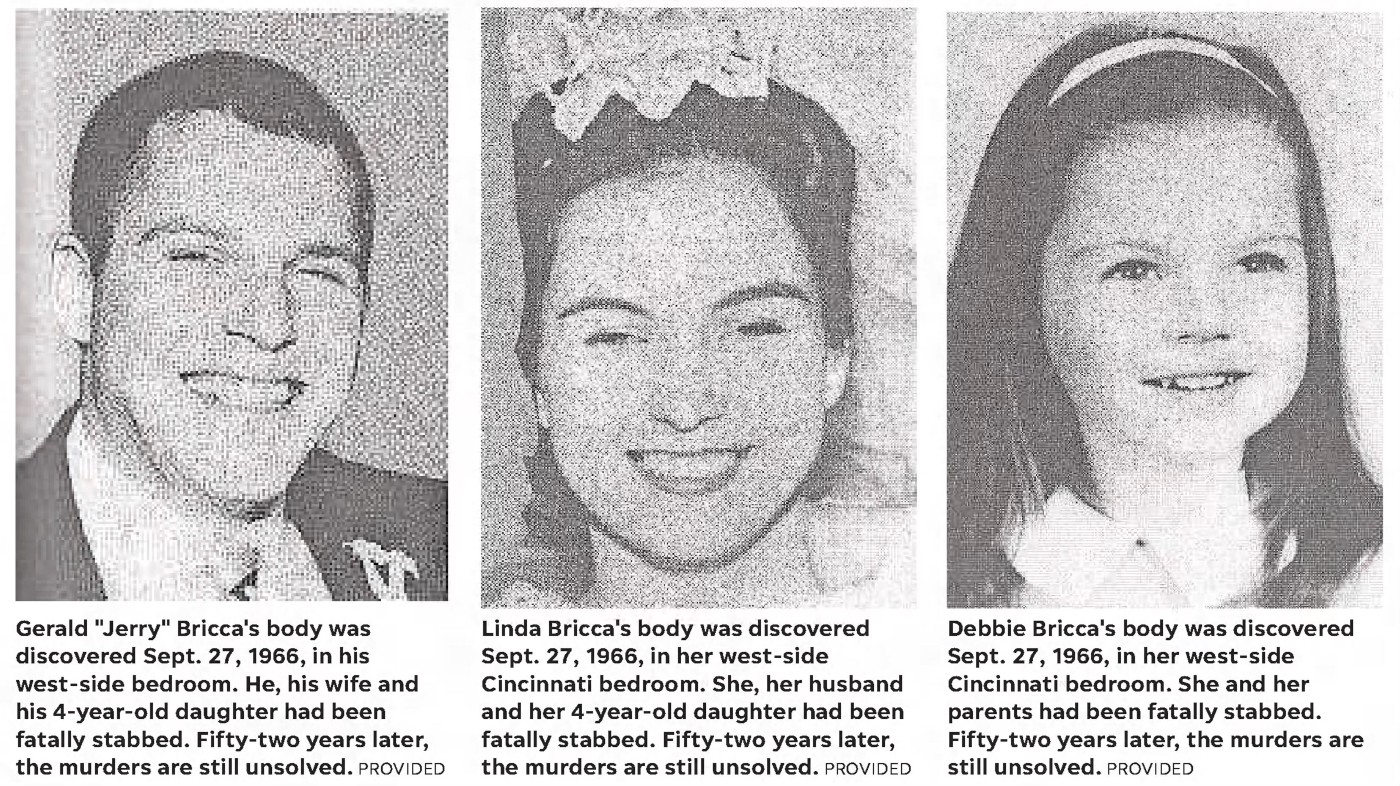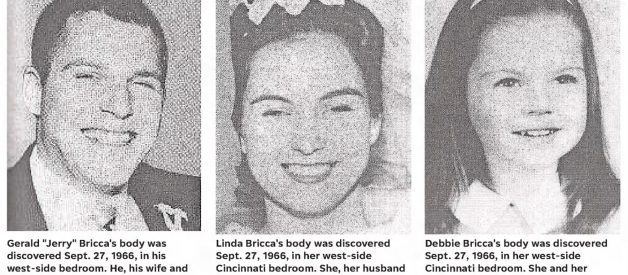 Photo source: Western Hills Press, December 26, 2018, via Newspapers.com
Photo source: Western Hills Press, December 26, 2018, via Newspapers.com
Gerald ?Jerry? Bricca married Linda Bulaw in Seattle, Washington, in 1961. Linda was born in Barrington Hills, Illinois. She and her family later relocated to Seattle, where she met Jerry and briefly worked as a flight attendant.
On June 6, 1962, Linda gave birth to the couple?s only child, Deborah Ann Bricca.
After the birth of their daughter, the Briccas relocated to Cincinnati, Ohio, and moved into a tri-level home at 3381 Greenway Avenue in the Bridgetown neighborhood in 1963.
Jerry, 28, was a hard-working chemical engineer with Monsanto, Co and often worked nights, weekends, and holidays. Linda stayed home for a few years after Debbie?s birth.
In 1966, Linda, 23, decided to go back to work and took a temporary part-time job with local veterinarian Dr. Fred Leininger at his Glenway Animal Hospital.
The Briccas were well-liked by their neighbors and often had get-togethers for backyard barbecues and holiday parties.
There?s no doubt the Briccas were living the American Dream, but someone shattered that dream in a moment of violence.
On Tuesday, September 27, 1966, neighbors of the Briccas started noticing odd things going on at the Bricca home. Jerry hadn?t brought in the trash cans from the curb, for one.
Their next-door neighbor, Richard Meyer, threw a local newspaper on the front porch, but no one had retrieved it.
The couple?s two vehicles sat in the driveway and on the street in front of the home, unmoved for two days.
The Meyers tried calling the Briccas. No one answered. Richard Meyer walked over to their home and noticed the front door ajar.
Around 10:40 p.m., Meyer told another neighbor, Richard Janszen of 3374 Greenway Avenue, about the door, and the two decided to go inside the Bricca home.
Janszen, a WWII veteran, recognized the smell as soon as he fully opened the door. He had smelled rotting flesh numerous times during his war days. And fear struck him like a bolt of lightning.
The men walked through the main level of the home and upstairs to the bedrooms.
Janszen and Meyer discovered the bodies of Jerry and Linda Bricca on the floor of their bedroom. Jerry was face down on the floor between the wall and the bed; Linda?s body was face up across her husband?s body.
Bricca?s daughter, Debbie, was found dead on her bedroom floor. Horrified at their discovery, Janszen and Meyer ran to call the police.
The Crime Scene
Soon after, authorities arrived at the crime scene to begin the investigation into the grisly murders.
Both the front and back doors of the home were closed but unlocked. There was no sign of forced entry or a struggle.
Police found a load of clothes in the dryer, located in the utility room next to the living room. The clothes were still damp. It appeared Linda had folded clothes recently because some were on the couch in the living room.
The family?s two dogs, Thumper and Dusty, were locked in a rear room unharmed. The SPCA later took charge of them.
A 6 1/2-inch knife from an Indian carving set made from teakwood and steel was missing.
An inscription, ?Rajba Bros, India,? was on the fork blade, and may have been on the knife which the police never found. Its mate was on top of the buffet in its sheath. There was no indication someone had ransacked the buffet.
Upstairs in the couple?s bedroom, police found the bodies. Jerry was fully clothed, except for shoes, a sock stuffed in his mouth. A piece of adhesive tape clung to his body, which suggested he and Linda were bound. Whatever material the killer used to tie their hands, he removed later.
Linda, clad in an unzipped housecoat over a nightgown, appeared to be getting ready for bed.
Debbie was wearing a flannel nightgown and one red sock. The mate was on her bed.
Jerry?s empty wallet laid on the couple?s bed. A robbery was considered a possible secondary motive in the murders.
Investigators found a bundle of about 15 short lengths of braided hemp rope in the garage the killer may have used to bind Jerry. They were all tied together and were extra ?tie-downs? for canvas Jerry bought to cover a rabbit hutch.
The rug was vacuumed and removed for analysis. The police dusted for fingerprints, and investigators did find a latent fingerprint, but nothing ever came from it.
Authorities collected a large box of evidence for examination. It included the victims? clothing, hair samples found in the house, bed sheets, and some bloody towels.
The Autopsy
Coroner Dr. Frank P. Cleveland performed the autopsies. Jerry and Linda had head wounds of ?a penetrative type, apparently not made by a knife.?
Marks were found on the adults? arms, confirming their hands were at some point during their ordeal.
All three victims had been stabbed in their chests and backs sometime between 10 p.m. and 6:30 a.m. Jerry had nine stab wounds and Linda, eight. The killer had raped Linda.
Debbie had been stabbed four times with such force the knife went all the way through her little body.
Dr. Cleveland could not determine the sequence of the murders.
The Investigation
Detectives traced dates on milk bottle caps and learned that Jerry bought three and a half gallons of milk at a Glenway Avenue dairy at 8:30 p.m. Sunday, September 25, 1966.
Through interviews, police discovered that Linda?s father telephoned her at 10:00 p.m. on Sunday to say he and her mother were about to leave on vacation.
Neighbors law saw Jerry Bricca between 9:00 p.m. and 10:00 p.m. Sunday taking trash cans to the curb for garbage pick-up.
The next morning at 6:30 a.m., the family did not respond to a phone call from Jerry?s employer, Monsanto Co. Addyston. Jerry was supposed to fly to Nitro, West Virginia, at 7:05 a.m., with Glen Ritchie, Monsanto products supervisor, on company business. Ritchie called to find out why Jerry was not at the airport.
Richard Meyer?s wife told police she noticed a suspicious man walking back and forth on Greenway Avenue on the Thursday before the murders.
?She was out in the garage painting tables for the rathskeller,? Richard said. ?She saw this man walking back and forth. She wondered about him. But she says she couldn?t identify his face now.?
Police suggested the killer used the missing newspaper to wrap and carry the bloody knife out of the Bricca home and possibly threw it away in the garbage bin.
All in all, authorities conducted 400 interviews in the investigation.
Did the Couple Know Their Killer?
There were several indications that Jerry and Linda Bricca knew their killer.
For one, there were no signs of forced entry or a struggle. However, detectives theorized the killer gained entry to the home through the walk-out basement entrance door.
Debbie was a curious child, so the missing knife was never left out in the open. Linda usually concealed it in one of the drawers. Police thought the killer murdered her because she may have recognized him.
The two family dogs, Dusty, mostly poodle, and Thumper, a cocker spaniel mix, were known to be aggressive and to bark at strangers, yet neighbors did not hear any barking coming from the Bricca home Sunday night. No sounds were coming from the house that night at all.
County police cleared Richard Meyer of involvement in the murders. Although he was never an official suspect, the Meyers received prank phone calls and harassment. The callers accused him of the killings. When he changed his phone number, they called him at work. However, He always cooperated with the police.
Several Murders in the Area
At the time of the Bricca family murder, seven unsolved murders, including the Briccas, occurred over ten months in the Cincinnati area.
Besides the Briccas, there were the murders of four women ? three were raped and strangled; the other fatally stabbed after being run over by a stolen taxicab. Police eventually arrested someone in that case.
On December 2, 1965, 56-year-old Emogene Harrison, wife of a University of Cincinnati space scientist, was found dead in the basement of her apartment building.
Four months later, Lois Dant, 58, was found dead in her Price Hill apartment on April 4, 1966.
The third victim, Jeannette M. Messer, 56, and a widow, was found deceased in a city park near the University of Cincinnati campus.
Police believed the same killer was responsible and dubbed him ?The Cincinnati Strangler.? They never identified him.
Initially, authorities wondered if the ?Strangler? had murdered the Bricca family due to the similarities. However, the killer mainly targeted older women. But the police did have a person of interest in the Bricca case.
The Veterinarian
Linda Bricca had worked for Dr. Fred Leininger at Glenway Animal Hospital before her murder. There were rumors the two were having an affair, and Leininger killed her and her family when she wanted to break things off (verify). There were also rumors Jerry had an affair.
Police did not publicly release Leininger?s name until years after the murders. But within days of the killings, police interviewed him for about 10 minutes in one session, and 45 minutes in another. The latter one was tape-recorded.
The next day, Lieutenant Herbert V. Vogel of the Ohio State Police visited Leininger?s wife, Lynn, who told Vogel her husband was upset by the interview and directed him to call their attorney, Richard Moor with further questions.
Vogel called Moor, but Moor had stipulations authorities had to meet before he would allow them to talk to his client. Initially, the police did not accept the terms.
A few months later, in March 1967, police wanted to question Leininger again and were willing to meet Moor?s terms, but the lawyer declined the interview.
A month earlier, Vogel sent Moor a letter agreeing to Moor?s terms, which partly included Moor be present at all times. The Cincinnati Enquirer, March 28, 1966 issue, reported Vogel also included seven questions he wanted to ask Leininger:
When did you last see Linda Bricca alive?
Did you see Linda Bricca on Thursday, September 22, 1966?
When did you last visit the Bricca residence?
For what reason did you last visit the Bricca residence?
Did Linda Bricca ever discuss with you any of her personal problems?
Were you ever out with Linda Bricca socially?
Where were you on Sunday night, September 25, 1966, between 9 p.m. and midnight?
Moor told County Detective Gerald Taylor that even if he received total compliance with his terms, he would ?study and consider it, but even then, I would probably not allow it.?
Vogel never received answers to those questions.
When Cincinnati Enquirer reporter, Frank Weikel asked Hamilton County police what was new with the investigation, a police official told him, ?We?re just about living with the suspect. A policeman checks on him from the time he leaves home in the morning and stays nearby until he returns for bed. One of our men even has lunch in the same restaurant where the suspect eats.?
Weikel wrote in his November 10, 1967 column, ?The knowledge that police are watching him apparently is having some effect on the suspect. I understand that his lunch cocktails are increasing. At first, he had one drink, but now he is having three drinks with his lunch.?
Unfortunately, Dr. Fred Leininger never cooperated with the police and worked in his veterinary practice until his retirement in 1995. Most people believe he killed the Bricca family.
Some reports vary on this, but apparently, Leininger committed suicide in 2004 at the age of 74. It?s confusing because they also say his wife, Lynn, committed suicide with him, but their obituaries give different death dates.
His obituary states Leininger died on February 23, 2004, while hers says she passed away months later on December 11, 2004. One report mentions only Leininger committed suicide.
JT Townsend
In 2018, armchair detective and true crime writer, JT Townsend published a book titled, Summer?s Almost Gone, (affiliate link) on the Bricca family murder. Authorities granted him access to the case files, and his book contains information not available anywhere else.


